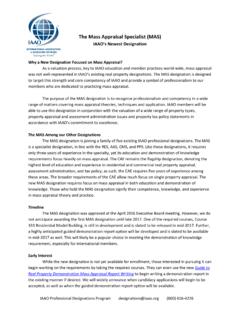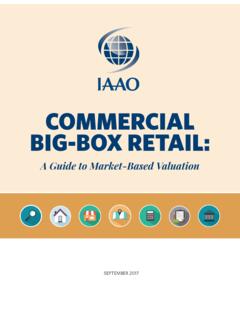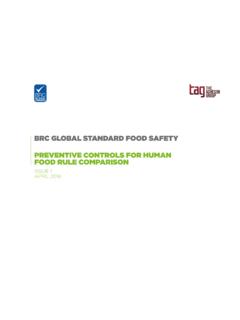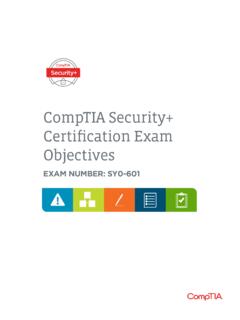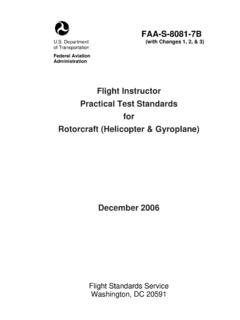Transcription of Ratio Studies - IAAO
1 Approved April 2013 International Association of Assessing OfficersIAAO assessment standards represent a consensus in the assessing profession and have been adopted by the Executive Board of the International Association of Assessing Officers (IAAO). The objective of the IAAO standards is to provide a systematic means for assessing officers to improve and standardize the operation of their offices. IAAO standards are advisory in nature and the use of, or compliance with, such standards is voluntary. If any portion of these standards is found to be in conflict with national, state, or provincial laws, such laws shall govern. Requirements found in the Uniform Standards of Professional Appraisal Practice (USPAP) also have precedence over technical on Ratio StudiesAcknowledgementsAt the time of the adoption of the standard by the IAAO Executive Board, the IAAO Technical Standards Committee was composed of Chair Bill Marchand; Alan Dornfest, AAS; Mary Reavey; Michael Prestridge, Dennis Deegear, Doug Warr, AAS.
2 Chris Bennett, Staff standard benefited from revisions by Robert Gloudemans and the 2011 and 2012 Technical Standard standard benefited from review and comment by Robert Denne, Patrick O'Connor, and Pete byInternational Association of Assessing Officers314 W 10th StKansas City, Missouri 64105-1616816/701-8100 Fax: 816/701-8149 978-0-88329-208-2 Copyright 2013 by the International Association of Assessing OfficersAll rights part of this publication may be reproduced in any form, in an electronic retrieval system or otherwise, without the prior written permission of the publisher. However, assessors wishing to use this standard for educating legislators and policymakers may photocopy it for limited in the United States of on Ratio StudiesPart 1. Guidance for Local Jurisdictions ..7 1. Scope ..7 2. Overview .. The Concepts of Market Value and Appraisal Accuracy .. Aspects of Appraisal Performance .. Uses of Ratio Studies .. Applicability.
3 8 3. Steps in Ratio Studies .. Definition of Purpose, Scope and Objectives .. Design (rev. March-2013) .. Level of Sophistication and Detail .. Sampling .. Limitations of Sale Samples .. Data Accuracy and Integrity .. Stratification .. Collection and preparation of Market Data .. Matching of Appraisal and Market Data (rev. Jan-2010) .. Statistical Analysis (rev. March-2013) .. Evaluation and Use of Results (rev. March-2013) ..10 4. Timing and Sample Selection .. Data Requirements and Availability .. Nature of the Population .. Assessment Information .. Indicators of Market Value .. Property Characteristics .. Frequency of Ratio Studies .. Date of Analysis .. Period from Which Sales Are Drawn .. Sample Representativeness (rev. March-2013) .. Acquisitions and Validation of Sales Data ..11 5. Ratio Study Statistics and Analyses (rev. March-2013) .. Data Displays .. Outlier Ratios (rev. March-2013) .. Measures of Appraisal Level.
4 Median .. Arithmetic Mean .. Weighted Mean .. Contrasting Measures of Appraisal Level .. Measures of Variability .. Coefficient of Dispersion .. Other Measures of Variability .. Measures of Reliability .. Vertical Inequities (rev. March-2013) .. Tests of Hypotheses (rev. March-2012) .. The Normal Distribution .. Parametric and Distribution-Free (Nonparametric) Statistics ..15 6. Sample Size .. Importance of Sample Size .. Adequacy of a Given Sample Size .. Required Sample Size .. Remedies for Inadequate Samples .. Other Sample Size-Related Representativeness Problems ..16 7. Reconciliation of Ratio Study Performance Measures ..16 8. Presentation of Findings, Documentation, and Training .. Text .. Exhibits .. Analyses and Conclusions .. Documentation .. Training and Education ..17 9. Ratio Study Standards .. Level of Appraisal (rev. March-2012) .. Purpose of Level-of-Appraisal Standard.
5 Confidence Intervals in Conjunction with Performance Standards .. Appraisal Uniformity (rev. March-2012) .. Uniformity among Strata .. Uniformity among Single-Family Residential Properties .. Uniformity among Income-Producing Properties .. Uniformity among Unimproved Properties .. Uniformity among Rural Residential and Seasonal Properties, Manufactured Housing, and Multifamily Dwellings .. Uniformity among Other Properties .. Vertical Equity .. Alternative Uniformity Standards .. Natural Disasters and Ratio Study Standards ..19 10. Personal Property Ratio Studies ..20 Part 2. Equalization and Performance Monitoring ..21 1. Scope ..21 2. Oversight Ratio Studies .. Monitoring of Appraisal Performance .. Equalization .. Direct Equalization .. Indirect Equalization ..22 3. Steps in Ratio Studies .. Definition of Purpose, Scope and Objectives .. Design of Study .. Level of Sophistication and Detail .. Sampling .. Determining the Composition of Samples.
6 Sale Samples .. Independent Appraisal Samples .. Samples Combining Sales and Independent Appraisals .. Collection and preparation of Market Data .. Stratification .. Matching Appraisal Data and Market Data (rev. Jan-2010) .. Stratification for Equalization Studies .. Stratification for Direct Equalization .. Stratification for Indirect Equalization .. Statistical Analysis .. Evaluation and Use of Results ..25 4. Timing and Sample Selection .. Date of Analysis .. Representativeness of Samples .. Maximizing Representativeness with Independent Appraisals .. Very-High-Value Properties ..26 5. Acquisition and Analysis of Sales Data .. Sale Adjustments for Statutorily Imposed Value Constraints .. Outlier Ratios (rev. March-2013) .. Value Outliers .. Outlier Trimming ..27 6. Ratio Study Statistics and Analyses .. Measures of Appraisal Level .. Overall Ratio for Combined Strata (rev. March-2012) .. Contrasting Measures of Appraisal Level.
7 Measures of Variability .. Measures of Reliability .. Vertical Inequities (rev. March-2013) .. Test of Hypotheses .. The Normal Distribution ..29 7. Sample Size .. Importance of Sample Size .. Adequacy of a Given Sample Size .. Required Sample Size .. Remedies for Inadequate Samples .. History of Sales Reporting ..30 8. Appraisal Ratio Studies .. Rationale .. Advantages and Disadvantages .. Sample Selection and Resource Requirements .. Data Requirements and Appraisal Techniques .. Appraisal Chasing .. Reviewing of Appraisals .. Combining of Sales and Appraisals .. Average Unit Value Comparisons ..32 9. Estimating Performance for Unsold Properties ..32 10. Presentation of Findings, Documentation, and Training (rev. Jan-2010) ..33 11. Ratio Study Standards (rev. March-2012) .. Level of Appraisal .. Purpose of Level-of-Appraisal Standard .. Recommended Appraisal Level Standards for Direct and Indirect Equalization.
8 Confidence Intervals in Conjunction with Performance Standards .. Decision Model .. Adjustments for High Variability and Small Samples .. Calculating Equalization Adjustments .. Appraisal Uniformity (rev. March-2013) .. Oversight Uniformity Standards .. Multi-level Uniformity Standards .. Uniformity among Strata .. Vertical Equity .. Natural Disasters and Ratio Study Standards ..36 12. Personal Property Studies .. The Performance Review .. Discovery .. Valuation .. Verification .. Forms and Renditions .. Appraisal Ratio Studies for Personal Property .. Assessment Ratio for Personal Property .. Stratification .. Property Escaping Assessment .. Identifying Personal Property Owners and Users Not in the Roll .. Identifying Personal Property Not Included in Taxpayer Returns/ Reports .. Computing the Level of Appraisal ..38 Definitions (rev. March-2012) ..39 References (rev. March-2012)..45 Additional Resources ..45 Appendix A. Sales Validation Guidelines.
9 Sources of Sales Data .. Information Required .. Confirmation of Sales .. Importance of Confirmation .. Methods of Confirmation .. Screening Sales .. Sales Generally Invalid for Ratio Studies .. Sales with Special Conditions .. Multiple-Parcel Sales .. Acquisitions or Divestments by Large Property Owners .. IRS 1031 Exchanges .. Internet Inaccurate Sale Data .. Adjustments to Sale Prices (rev. Jan-2010) .. Adjustments for Financing .. Adjustments for Assumed Leases .. Adjustments for Personal Property .. Adjustments for Time .. Other Adjustments .. Special Assessments ..52 Appendix B. Outlier Trimming Guidelines .. Identification of Ratio Outliers (rev. March-2013) .. Scrutiny of Identified Outliers .. Outlier Trimming .. Trimming Limitations .. Analytical Use of Identified Outliers .. Reporting Trimmed Outliers and Results ..54 Appendix C. Median Confidence Interval Tables for Small Samples ..55 Appendix D. Coefficient of Price-Related Bias (revised March-2013).
10 56 Appendix E. Sales Chasing Detection Techniques .. Comparison of Average Value Changes .. Comparison of Average Unit Values .. Split Sample Technique .. Comparison of Observed versus Expected Distribution of Ratios .. Mass Appraisal Techniques ..60 Appendix F. Alternative Uses for Ratio Study Statistics ..61 Appendix G. Legal Aspects of Ratio Studies ..61 Appendix H. Sales Validation Questionnaire ..627 STANDARD ON Ratio Studies 2013 This standard comprises two major parts. Part 1 focuses on the needs of local assessors. Part 2 presents guidelines for oversight agencies that use Ratio Studies for equalization and appraisal performance monitoring. The Definitions section explains the terms used in this standard. The ap-pendixes present many technical issues in greater detail. More information on many topics addressed in this stan-dard can be found in Property Appraisal and Assessment Administration (IAAO 1990, chapter 20) and in Gloude-mans (1999, chapter 5).

